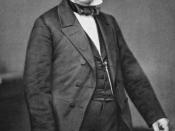Instances in the past have shown us just how well the U.S. can deal with its problems and still remain as a whole. Several times before in history the southern and northern parts of the United States have had differences of opinions, but the U.S. was always able to pull together and find a solution to their problem. In 1787 there was a dispute over how the government would be made up. The northern states and Madison wanted and proposed to have proportional representation, which meant that they would have a majority because there were more people in the North. William Paterson and the South called for equal representation. The dispute lead to the forming of The Great Compromise, which consisted of the House of Representatives and the Senate. The House would be made up by proportional representation and the Senate would be run under equal representation. Another issue still in 1787 was the question if slaves would count when calculating the population of states.
The south of course wanted to count slaves, but the North refused to count them. This lead to the Three-Fifths Compromise that stated that slaves would count as 3/5 of one person. This compromises satisfied both the North and south without giving either a majority.
In 1820 a north and south dispute sprang up again, this time it was about the position of new states that entered the Union, whether the new states were going to be closed or open to slavery. In 1819 Missouri applied for statehood, both north and south want Missouri, because it would give the majority to whoever was fortunate enough to get a hold on Missouri. James Tallmadge tries gradual emancipation of slaves; it was rejected in the Senate where the South had an equal amount of representatives (twenty-two of...


